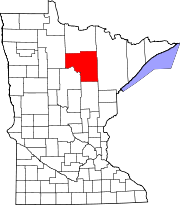La Prairie, Minnesota
La Prairie | ||
|---|---|---|
FIPS code 27-35648[2] | | |
| GNIS feature ID | 0656924[3] | |
La Prairie is a city in
U.S. Highways 2 and 169 are two of the main routes in La Prairie.
History
A post office was in operation at La Prairie from 1890 until 1917.
Geography
According to the United States Census Bureau, the city has a total area of 1.69 square miles (4.38 km2), of which 1.64 square miles (4.25 km2) is land and 0.05 square miles (0.13 km2) is water.[7]
La Prairie is adjacent to the city of Grand Rapids.
Demographics
| Census | Pop. | Note | %± |
|---|---|---|---|
| 1900 | 88 | — | |
| 1910 | 48 | −45.5% | |
| 1920 | 63 | 31.3% | |
| 1930 | 43 | −31.7% | |
| 1940 | 69 | 60.5% | |
| 1950 | 88 | 27.5% | |
| 1960 | 243 | 176.1% | |
| 1970 | 413 | 70.0% | |
| 1980 | 536 | 29.8% | |
| 1990 | 438 | −18.3% | |
| 2000 | 605 | 38.1% | |
| 2010 | 665 | 9.9% | |
| 2020 | 653 | −1.8% | |
| U.S. Decennial Census[8] | |||
2010 census
As of the
There were 270 households, of which 30.4% had children under the age of 18 living with them, 54.1% were married couples living together, 10.7% had a female householder with no husband present, 3.3% had a male householder with no wife present, and 31.9% were non-families. 27.4% of all households were made up of individuals, and 12.6% had someone living alone who was 65 years of age or older. The average household size was 2.39 and the average family size was 2.86.
The median age in the city was 41.8 years. 24.5% of residents were under the age of 18; 7.2% were between the ages of 18 and 24; 21.5% were from 25 to 44; 28.2% were from 45 to 64; and 18.8% were 65 years of age or older. The gender makeup of the city was 49.3% male and 50.7% female.
2000 census
As of the
There were 239 households, out of which 32.6% had children under the age of 18 living with them, 60.3% were married couples living together, 9.2% had a female householder with no husband present, and 26.8% were non-families. 20.1% of all households were made up of individuals, and 4.6% had someone living alone who was 65 years of age or older. The average household size was 2.50 and the average family size was 2.90.
In the city, the population was spread out, with 25.1% under the age of 18, 7.8% from 18 to 24, 26.3% from 25 to 44, 27.9% from 45 to 64, and 12.9% who were 65 years of age or older. The median age was 40 years. For every 100 females, there were 106.5 males. For every 100 females age 18 and over, there were 103.1 males.
The median income for a household in the city was $39,375, and the median income for a family was $50,250. Males had a median income of $41,125 versus $23,681 for females. The
References
- ^ "2020 U.S. Gazetteer Files". United States Census Bureau. Retrieved July 24, 2022.
- ^ a b "U.S. Census website". United States Census Bureau. Retrieved January 31, 2008.
- ^ "US Board on Geographic Names". United States Geological Survey. October 25, 2007. Retrieved January 31, 2008.
- ^ "2010 Census Redistricting Data (Public Law 94-171) Summary File". American FactFinder. U.S. Census Bureau, 2010 Census. Retrieved April 23, 2011.[dead link]
- ^ "Itasca County". Jim Forte Postal History. Retrieved July 12, 2015.
- ^ Upham, Warren (1920). Minnesota Geographic Names: Their Origin and Historic Significance. Minnesota Historical Society. p. 255.
- ^ "US Gazetteer files 2010". United States Census Bureau. Archived from the original on January 25, 2012. Retrieved November 13, 2012.
- ^ "Census of Population and Housing". Census.gov. Retrieved June 4, 2015.
- ^ "U.S. Census website". United States Census Bureau. Retrieved November 13, 2012.

